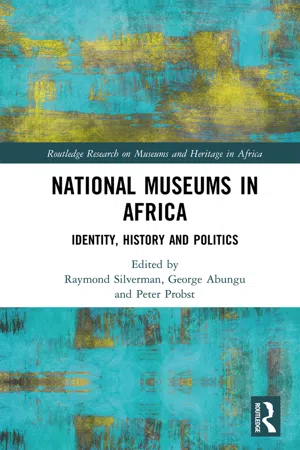
National Museums in Africa
Identity, History and Politics
Raymond Silverman, George Abungu, Peter Probst, Raymond Silverman, George Abungu, Peter Probst
- 368 pagine
- English
- ePUB (disponibile sull'app)
- Disponibile su iOS e Android
National Museums in Africa
Identity, History and Politics
Raymond Silverman, George Abungu, Peter Probst, Raymond Silverman, George Abungu, Peter Probst
Informazioni sul libro
National Museums in Africa brings the voices of African museum professionals into dialogue with scholars and, by so doing, is able to consider the state of African national museums from fresh perspectives.
Covering all regions of the continent, the volume's thirteen chapters allow for a deep and nuanced understanding of the intricate interplay between past and present in contemporary Africa. Taking stock of the shifting museum landscape in Africa, with new players like China and South Korea challenging the conditions of cultural exchange, the book demonstrates that national museums are being rediscovered as important sites of political engagement and cultural negotiation. This is the first book to critically examine the roles national museums in Africa have played in the societies in which they are situated, but it is also the first to consider the roles that national museums might play in current debates concerning the restitution and repatriation of cultural patrimony taken from Africa during the colonial era.
Informed by a comparative and interdisciplinary perspective, this ground-breaking book will appeal to anyone interested in museums in Africa. It will be particularly useful to scholars and students working in the areas of museum and heritage studies, African studies, anthropology, archaeology, history, art history and cultural studies.
Domande frequenti
Informazioni
Chapter 1
Visibility, democracy and the national museum network in Morocco
MUSEUM BRIEF
- Name of museum network: National Foundation for Museums (Fondation nationale des musées)
- Date museum network was founded: April 18, 2011
- Governance: Directed by a not-for-profit institution, working on behalf of the state
- Size: Multiple sites, therefore unknown
- Number of museums in network: 14
- Organization of museum (names of departments): Foundation headquarters in Rabat (president, 6 board members, 12 staff members); regional museums (51 staff members, each museum with a curator, an assistant curator, technical assistants, security and janitorial staff)
- Size of collections (number of objects): Over 65,000 (inventory of existing collections currently in progress)
- Nature of collections: Ethnographic, archaeological, modern and contemporary fine arts
- Size of staff (number of employees): 63 (2017)
- Annual budget in USD: $4.5 million (2019)
- Number of visitors per year: 350,000 (2017)
Introduction
The invisible museum? Public museums at the margins (1956–2010)
Museum | City | Date of creation | Type |
|---|---|---|---|
Dar Batha Museum | Fez | 1915 | Ethnographic |
Oudaïas Museum | Rabat | 1915 | Ethnographic |
Dar Jamai Museum | Meknès | 1920 | Ethnographic |
Museum of the Kasbah | Tanger | 1922 | Ethno-archaeological |
Bab Oqla Museum | Tétouan | 1922 | Ethnographic |
Archaeology Museum | Rabat | 1930 | Archaeological |
Dar Si Saïd Museum | Marrakech | 1939 | Ethnographic |
Archaeology Museum | Tétouan | 1939 | Archaeological |
Archaeology Museum | Larache | 1973 | Archaeological |
Sidi Mohammed Ben Abdellah Museum | Essaouira | 1980 | Ethnographic |
Ethnographic Museum | Chefchaouen | 1985 | Ethnographic |
Museum of Pottery | Safi | 1990 | Specialized |
Museum of Contemporary Art | Tanger | 1990 | Specialized |
Borj Belqari Museum of Pottery of the Rif and pre-Rif | Meknès | 2004 | Specialized |
Museum of Saharan Arts | Laâyoune | 2000 | Ethnographic |
Indice dei contenuti
- Cover
- Half Title
- Series Page
- Title Page
- Copyright Page
- Contents
- List of figures
- List of tables
- List of contributors
- Introduction: Regarding national museums in Africa
- 1 Visibility, democracy and the national museum network in Morocco
- 2 The Sudan National Museum and national heritage in Sudan
- 3 National identities and the National Museum of Ethiopia
- 4 National Museums of Kenya: From inception to the post-devolution era
- 5 Collecting obsolete things at the Uganda Museum
- 6 Korea and the New National Museum in the Democratic Republic of the Congo: Building a museum, building relations?
- 7 Le Musée des Civilisations Noires: A continuous creation of humanity
- 8 The National Museum of Mali, 1960–present: Protecting and promoting the national cultural heritage
- 9 Le Musée National Boubou Hama du Niger: A return to research
- 10 Giving the National Museum of Ghana a new life
- 11 The Nigerian National Museums and the challenges of national unity and development: The Black Benz and the return of lost treasures
- 12 Toward a critical history of the National Museums and Monuments of Zimbabwe: Rethinking pastness and materiality
- 13 Rethinking the national and the museum at Iziko Museums of South Africa
- Coda: National museums in Africa: A conversation
- Index